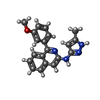+ Open data
Open data
- Basic information
Basic information
| Entry | Database: PDB / ID: 3w10 | ||||||
|---|---|---|---|---|---|---|---|
| Title | Aurora kinase A complexed to pyrazole aminoquinoline I | ||||||
 Components Components | Aurora kinase A | ||||||
 Keywords Keywords | TRANSFERASE/TRANSFERASE INHIBITOR /  kinase / pyrazole aminoquinoline / TRANSFERASE-TRANSFERASE INHIBITOR complex kinase / pyrazole aminoquinoline / TRANSFERASE-TRANSFERASE INHIBITOR complex | ||||||
| Function / homology |  Function and homology information Function and homology informationInteraction between PHLDA1 and AURKA /  regulation of centrosome cycle / regulation of centrosome cycle /  axon hillock / spindle assembly involved in female meiosis I / cilium disassembly / spindle pole centrosome / positive regulation of oocyte maturation / histone H3S10 kinase activity / chromosome passenger complex / axon hillock / spindle assembly involved in female meiosis I / cilium disassembly / spindle pole centrosome / positive regulation of oocyte maturation / histone H3S10 kinase activity / chromosome passenger complex /  pronucleus ...Interaction between PHLDA1 and AURKA / pronucleus ...Interaction between PHLDA1 and AURKA /  regulation of centrosome cycle / regulation of centrosome cycle /  axon hillock / spindle assembly involved in female meiosis I / cilium disassembly / spindle pole centrosome / positive regulation of oocyte maturation / histone H3S10 kinase activity / chromosome passenger complex / axon hillock / spindle assembly involved in female meiosis I / cilium disassembly / spindle pole centrosome / positive regulation of oocyte maturation / histone H3S10 kinase activity / chromosome passenger complex /  pronucleus / pronucleus /  meiotic spindle / mitotic centrosome separation / meiotic spindle / mitotic centrosome separation /  germinal vesicle / protein localization to centrosome / anterior/posterior axis specification / centrosome localization / neuron projection extension / positive regulation of mitochondrial fission / spindle organization / mitotic spindle pole / SUMOylation of DNA replication proteins / spindle midzone / regulation of G2/M transition of mitotic cell cycle / germinal vesicle / protein localization to centrosome / anterior/posterior axis specification / centrosome localization / neuron projection extension / positive regulation of mitochondrial fission / spindle organization / mitotic spindle pole / SUMOylation of DNA replication proteins / spindle midzone / regulation of G2/M transition of mitotic cell cycle /  centriole / protein serine/threonine/tyrosine kinase activity / positive regulation of mitotic cell cycle / AURKA Activation by TPX2 / mitotic spindle organization / positive regulation of mitotic nuclear division / TP53 Regulates Transcription of Genes Involved in G2 Cell Cycle Arrest / ciliary basal body / negative regulation of protein binding / centriole / protein serine/threonine/tyrosine kinase activity / positive regulation of mitotic cell cycle / AURKA Activation by TPX2 / mitotic spindle organization / positive regulation of mitotic nuclear division / TP53 Regulates Transcription of Genes Involved in G2 Cell Cycle Arrest / ciliary basal body / negative regulation of protein binding /  regulation of cytokinesis / regulation of signal transduction by p53 class mediator / molecular function activator activity / regulation of cytokinesis / regulation of signal transduction by p53 class mediator / molecular function activator activity /  liver regeneration / FBXL7 down-regulates AURKA during mitotic entry and in early mitosis / liver regeneration / FBXL7 down-regulates AURKA during mitotic entry and in early mitosis /  regulation of protein stability / APC/C:Cdh1 mediated degradation of Cdc20 and other APC/C:Cdh1 targeted proteins in late mitosis/early G1 / regulation of protein stability / APC/C:Cdh1 mediated degradation of Cdc20 and other APC/C:Cdh1 targeted proteins in late mitosis/early G1 /  mitotic spindle / mitotic spindle /  kinetochore / spindle / response to wounding / microtubule cytoskeleton / G2/M transition of mitotic cell cycle / kinetochore / spindle / response to wounding / microtubule cytoskeleton / G2/M transition of mitotic cell cycle /  Regulation of PLK1 Activity at G2/M Transition / positive regulation of proteasomal ubiquitin-dependent protein catabolic process / mitotic cell cycle / midbody / proteasome-mediated ubiquitin-dependent protein catabolic process / basolateral plasma membrane / peptidyl-serine phosphorylation / Regulation of TP53 Activity through Phosphorylation / Regulation of PLK1 Activity at G2/M Transition / positive regulation of proteasomal ubiquitin-dependent protein catabolic process / mitotic cell cycle / midbody / proteasome-mediated ubiquitin-dependent protein catabolic process / basolateral plasma membrane / peptidyl-serine phosphorylation / Regulation of TP53 Activity through Phosphorylation /  microtubule / microtubule /  postsynaptic density / protein autophosphorylation / postsynaptic density / protein autophosphorylation /  non-specific serine/threonine protein kinase / non-specific serine/threonine protein kinase /  protein kinase activity / protein heterodimerization activity / protein kinase activity / protein heterodimerization activity /  cell division / cell division /  protein phosphorylation / negative regulation of gene expression / protein serine kinase activity / protein serine/threonine kinase activity / protein phosphorylation / negative regulation of gene expression / protein serine kinase activity / protein serine/threonine kinase activity /  centrosome / glutamatergic synapse / apoptotic process / centrosome / glutamatergic synapse / apoptotic process /  ubiquitin protein ligase binding / negative regulation of apoptotic process / ubiquitin protein ligase binding / negative regulation of apoptotic process /  protein kinase binding / perinuclear region of cytoplasm / protein kinase binding / perinuclear region of cytoplasm /  nucleoplasm / nucleoplasm /  ATP binding / ATP binding /  nucleus / nucleus /  cytosol cytosolSimilarity search - Function | ||||||
| Biological species |   Homo sapiens (human) Homo sapiens (human) | ||||||
| Method |  X-RAY DIFFRACTION / X-RAY DIFFRACTION /  SYNCHROTRON / SYNCHROTRON /  MOLECULAR REPLACEMENT / Resolution: 2.7 Å MOLECULAR REPLACEMENT / Resolution: 2.7 Å | ||||||
 Authors Authors | Oliveira, T.M. / Kairies, N.A. / Engh, R.A. | ||||||
 Citation Citation |  Journal: To be Published Journal: To be PublishedTitle: Flexibility and multiple conformations of the activation and glycine rich loops of Aurora A accompanying inhibitor binding Authors: Oliveira, T.M. / Kairies, N.A. / Engh, R.A. | ||||||
| History |
|
- Structure visualization
Structure visualization
| Structure viewer | Molecule:  Molmil Molmil Jmol/JSmol Jmol/JSmol |
|---|
- Downloads & links
Downloads & links
- Download
Download
| PDBx/mmCIF format |  3w10.cif.gz 3w10.cif.gz | 64 KB | Display |  PDBx/mmCIF format PDBx/mmCIF format |
|---|---|---|---|---|
| PDB format |  pdb3w10.ent.gz pdb3w10.ent.gz | 50 KB | Display |  PDB format PDB format |
| PDBx/mmJSON format |  3w10.json.gz 3w10.json.gz | Tree view |  PDBx/mmJSON format PDBx/mmJSON format | |
| Others |  Other downloads Other downloads |
-Validation report
| Arichive directory |  https://data.pdbj.org/pub/pdb/validation_reports/w1/3w10 https://data.pdbj.org/pub/pdb/validation_reports/w1/3w10 ftp://data.pdbj.org/pub/pdb/validation_reports/w1/3w10 ftp://data.pdbj.org/pub/pdb/validation_reports/w1/3w10 | HTTPS FTP |
|---|
-Related structure data
- Links
Links
- Assembly
Assembly
| Deposited unit | 
| ||||||||
|---|---|---|---|---|---|---|---|---|---|
| 1 |
| ||||||||
| Unit cell |
|
- Components
Components
| #1: Protein |  / Aurora 2 / Aurora/IPL1-related kinase 1 / ARK-1 / Aurora-related kinase 1 / hARK1 / Breast tumor- ...Aurora 2 / Aurora/IPL1-related kinase 1 / ARK-1 / Aurora-related kinase 1 / hARK1 / Breast tumor-amplified kinase / Serine/threonine-protein kinase 15 / Serine/threonine-protein kinase 6 / Serine/threonine-protein kinase aurora-A / Aurora 2 / Aurora/IPL1-related kinase 1 / ARK-1 / Aurora-related kinase 1 / hARK1 / Breast tumor- ...Aurora 2 / Aurora/IPL1-related kinase 1 / ARK-1 / Aurora-related kinase 1 / hARK1 / Breast tumor-amplified kinase / Serine/threonine-protein kinase 15 / Serine/threonine-protein kinase 6 / Serine/threonine-protein kinase aurora-AMass: 32154.855 Da / Num. of mol.: 1 / Fragment: Domain, UNP RESIDUES 126-403 / Mutation: T287A, T288A Source method: isolated from a genetically manipulated source Source: (gene. exp.)   Homo sapiens (human) Homo sapiens (human)Gene: AURKA, AIK, AIRK1, ARK1, AURA, AYK1, BTAK, IAK1, STK15, STK6 Production host:   Escherichia coli (E. coli) Escherichia coli (E. coli)References: UniProt: O14965,  non-specific serine/threonine protein kinase non-specific serine/threonine protein kinase |
|---|---|
| #2: Chemical | ChemComp-RO9 / |
| #3: Water | ChemComp-HOH /  Water Water |
-Experimental details
-Experiment
| Experiment | Method:  X-RAY DIFFRACTION / Number of used crystals: 1 X-RAY DIFFRACTION / Number of used crystals: 1 |
|---|
- Sample preparation
Sample preparation
| Crystal | Density Matthews: 2.98 Å3/Da / Density % sol: 58.78 % |
|---|---|
Crystal grow | Temperature: 298 K / Method: vapor diffusion, hanging drop / pH: 7 Details: PEG 3350, pH 7.0, VAPOR DIFFUSION, HANGING DROP, temperature 298K |
-Data collection
| Diffraction | Mean temperature: 298 K |
|---|---|
| Diffraction source | Source:  SYNCHROTRON / Site: SYNCHROTRON / Site:  BESSY BESSY  / Beamline: 14.1 / Wavelength: 1.488 Å / Beamline: 14.1 / Wavelength: 1.488 Å |
| Detector | Type: MAR CCD 165 mm / Detector: CCD / Date: Oct 1, 2010 |
| Radiation | Monochromator: graphite / Protocol: SINGLE WAVELENGTH / Monochromatic (M) / Laue (L): M / Scattering type: x-ray |
| Radiation wavelength | Wavelength : 1.488 Å / Relative weight: 1 : 1.488 Å / Relative weight: 1 |
| Reflection | Resolution: 2.7→26.54 Å / Num. all: 11390 / Num. obs: 10633 / % possible obs: 70 % / Observed criterion σ(F): 3 / Observed criterion σ(I): 2 |
| Reflection shell | Resolution: 2.7→3 Å / % possible all: 70 |
- Processing
Processing
| Software |
| |||||||||||||||||||||||||||||||||||||||||||||||||||||||||||||||||
|---|---|---|---|---|---|---|---|---|---|---|---|---|---|---|---|---|---|---|---|---|---|---|---|---|---|---|---|---|---|---|---|---|---|---|---|---|---|---|---|---|---|---|---|---|---|---|---|---|---|---|---|---|---|---|---|---|---|---|---|---|---|---|---|---|---|---|
| Refinement | Method to determine structure : :  MOLECULAR REPLACEMENT / Resolution: 2.7→26.54 Å / Cor.coef. Fo:Fc: 0.909 / Cor.coef. Fo:Fc free: 0.844 / SU B: 15.943 / SU ML: 0.325 / Cross valid method: THROUGHOUT / σ(F): 2 / ESU R: 0.777 / ESU R Free: 0.391 / Stereochemistry target values: MAXIMUM LIKELIHOOD / Details: HYDROGENS HAVE BEEN ADDED IN THE RIDING POSITIONS MOLECULAR REPLACEMENT / Resolution: 2.7→26.54 Å / Cor.coef. Fo:Fc: 0.909 / Cor.coef. Fo:Fc free: 0.844 / SU B: 15.943 / SU ML: 0.325 / Cross valid method: THROUGHOUT / σ(F): 2 / ESU R: 0.777 / ESU R Free: 0.391 / Stereochemistry target values: MAXIMUM LIKELIHOOD / Details: HYDROGENS HAVE BEEN ADDED IN THE RIDING POSITIONS
| |||||||||||||||||||||||||||||||||||||||||||||||||||||||||||||||||
| Solvent computation | Ion probe radii: 0.8 Å / Shrinkage radii: 0.8 Å / VDW probe radii: 1.4 Å / Solvent model: MASK | |||||||||||||||||||||||||||||||||||||||||||||||||||||||||||||||||
| Displacement parameters | Biso mean: 44.357 Å2
| |||||||||||||||||||||||||||||||||||||||||||||||||||||||||||||||||
| Refinement step | Cycle: LAST / Resolution: 2.7→26.54 Å
| |||||||||||||||||||||||||||||||||||||||||||||||||||||||||||||||||
| Refine LS restraints |
| |||||||||||||||||||||||||||||||||||||||||||||||||||||||||||||||||
| LS refinement shell | Resolution: 2.7→2.77 Å / Total num. of bins used: 20
|
 Movie
Movie Controller
Controller



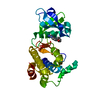


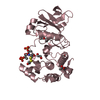
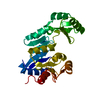
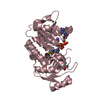
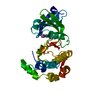
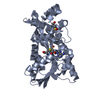
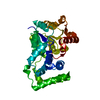

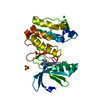

 PDBj
PDBj









